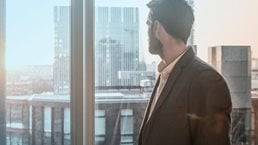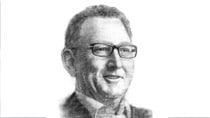The New Zealand Super Fund invests to fund the future pensions (or “superannuation,” as it is called there) of the country’s 65-and-over population. The fund has about $24 billion under management and has returned 15 percent annually for the past five years. Adrian Orr became CEO in 2007. McKinsey’s Bryce Klempner and Marcos Tarnowski spoke with him recently about how the fund is navigating today’s investment climate while keeping a resolute focus on the long term.
McKinsey: Let’s begin with the macro environment. Clearly, some big changes are taking place in many parts of the world. How would you characterize today’s investing climate?
Adrian Orr: Equity markets, particularly in the United States, are placing their trust in a never-before-seen home-run policy that the US president has described by tweet, including tax relief for corporations and increased government spending on infrastructure. These policy changes are fully priced in. The way we’re trying to express that view in our portfolio is that we have gone underweight US equities relative to our benchmark. Elsewhere, European markets seem underpriced relative to the long-term fair-value measures that we use, and so we are overweighted.
McKinsey: How is New Zealand Super playing to its strengths in the current environment?
Adrian Orr: It’s going to be a really good test of our governance and our fortitude. We’ve had a great run because we were suitably overweight equities post the global financial crisis, in line with our investing horizon and the liquidity of our positions. This time, when we actually start going underweight, the market may still be trending north. That might turn out to be a real test of our convictions, as people will be asking, “Why aren’t you taking advantage of this surge in equity markets?” So this situation is the reverse of 2008, and it’s a difficult test. If you underperform rising markets because of a long-term view that they are overvalued, there will be no shortage of questions about the wisdom of your decision.
Stay current on your favorite topics
McKinsey: Let’s talk more about some of the distinctive characteristics of the fund, which you call your “endowments”: your long time horizon, your liquidity profile, and your independence.
Adrian Orr: These are critical for us. When the fund was established, in 2001, global best practice in sovereign-wealth-fund investing did not really exist. When I joined, I found out very quickly there’s not even common practice, let alone best practice. That’s why we went into an eager-outreach mode, visiting many, many funds globally to learn how they worked. We found that the most effective thing we could do was to look very hard at who we are and what “events” we should participate in if we wanted to win the gold medal in investing. It was fascinating, and it took a long time. We spent years debating who we are and how we can properly reflect that identity in the way we behave.
McKinsey: Your mandate allows you a relatively long time horizon.
Adrian Orr: Yes. Our mandate is intergenerational: our stated purpose is to prefund the cost of superannuation in order to reduce the burden on future taxpayers. The fund is not used for current pension expenses, and we won’t start making payments until mid-2030s. Even then, the fund will continue to grow. So that gives us a long horizon for investing, which for us means much more than just buying long-dated assets. We think of it more as being able to repeat investment activity for as long as the institution exists. So we can make both high-frequency investments and long-dated investments; we can choose the horizon on which we want to pursue particular investment activities.
McKinsey: What about your liquidity profile?
Adrian Orr: Liquidity is a significant strength if it is managed right. Almost everything we think about daily is related to preserving functionality and ensuring our ability to buy and sell at our preference, rather than being forced into situations. Here again, there was no obvious global best practice. We ended up building significant systems to manage marginal pricing liquidity. Every asset that comes into the portfolio is categorized with regard to its liquidity features, so that if and when something has to be sold, we know exactly how and why. That has been an excellent discipline in the fund.
McKinsey: You also enjoy a measure of independence in operating the fund.
Adrian Orr: Our operational independence derives from our legislation. The board is well removed from the fund’s owner—the New Zealand government—so it has operational independence very similar to that of a central bank. But we have to continually remind ourselves, our board, and especially our stakeholders that operational independence is absolutely critical to maintaining our long-term horizon and investment discipline. It’s not easy. Our purpose and our goals have been defined by a democratic process, but we are operationally independent. That forces us to be very transparent and direct with the public about our work. And it forces us and the board to continually check ourselves, to make sure that we are investing for the fund, rather than managing for careers or for reputational risk around the short-term hiccups. I honestly believe that this independence is a defining difference between the New Zealand Super Fund and many other sovereign-wealth funds, and also US state pension funds.
In certain situations, our ownership structure could be seen as a hindrance, but in other situations, it is an advantage, as we are able at times to access investments that wouldn’t otherwise be available. We recently bought, for example, a large stake in a government-owned bank here in New Zealand, and we were better able to negotiate and close the deal because the public could see that the government remains the owner.
McKinsey: We see some of your peers moving aggressively to a direct-investing model—building internal teams, sometimes focused on sectors; opening international offices; sometimes creating operating platforms in areas like real estate. You haven’t yet taken that direction. How do you think about that decision?
Adrian Orr: This is a tough question for us, positioned as we are on the far side of the world. About every two years, we sit down and question if we should have international offices and build larger teams. The decision has always been no, because we’ve found it hard to justify—not on a cost basis, but on the basis of expected returns. Currently, we’re all in one place and effectively almost all on one floor. Everyone knows everything, which is incredibly powerful. It allows us to move very fast, and there are no industry or sector or regional disputes. We’re all focused on the single return of the fund. Individuals don’t have benchmarks for a sector or a country. So we have a single-fund, whole-fund culture. When you take a step into new regions, you need to have critical mass in those offices, and they end up having their own culture. It gets incredibly complex very quickly, and I just don’t believe that with our asset size we need to do it.
What we do, though, is think hard about it. We do a five-year plan, and every five years we think about what has happened to the size of the fund, and how scalable our activities are. That’s an important discussion, because certain investment activities may be comfortable and quite scalable, with similar resource needs, but others may not. You might have to say, “We’re not going to play that particular game anymore.” In other words, preserve the culture, preserve scalability, and don’t go out and grab tigers by the tail that cause you to build a large team.
So that’s how we’ve considered direct investing to date. I don’t believe we’ve been ruled out of any particular investment activity. We’ve been able to co-invest with external managers and peers, and invest directly. Every now and again, however, I do get wobbly. There are moments when we’re in trouble with some investment. You see management spending 90 percent of their time on 15 percent of the portfolio. And I think, “Imagine if we had three of these events happening at one time.” It forces me to ask, “Is this really scalable? Is it manageable?”
McKinsey: Some time ago, you started using a thematic investment approach. How do you develop these themes, and how do they evolve over time?
Adrian Orr: It was quite controversial inside our shop to go down the thematic path. In the end, the reason we chose to was that it aggregates effort around certain places, rather than just thinking the whole world is available. When the whole world is available, it’s very difficult to organize and create suitable investment processes. To find the themes, we know that we don’t have a monopoly on knowledge, so we linked with experts in many areas to think about what is really happening over the long term. That helped us find themes related to climate change and demography. Those two concepts helped us aggregate, or at least concentrate, our effort in looking for investment opportunities.
Have we since gone on to create a portfolio directly related to those themes? No. We are still highly diversified. Where we have taken on some active investment risk, we have aggregated around themes. One example is our alternative-energy work, which I have to say is incredibly difficult; there are not a lot of opportunities, and they’re all quite young. And every now and again, we get sufficiently comfortable that we can invest directly, for example, in retirement care. Being able to reflect the investment back onto some of those themes gives us more confidence in our expectations.
McKinsey: Beyond thematic investing, you’re generally recognized for an innovative model overall. Are there any new innovations on the horizon for New Zealand Super?
Adrian Orr: The first ten years of the fund were really about developing the framework of the investment strategy. If we did that right, then we should not have to change a lot in terms of the way we operate. Our endowments, investment beliefs, and the values-based culture we made—those shouldn’t change, because they should be the structural pillars of the institution. What will change is the set of investment opportunities. These will come and go as each has its day in the sun. We’ve already had to turn the switch off for some of them, saying, “That was great, but it’s no longer working.” In other areas we’ve had to really gear ourselves up to take advantage. So it’s about being flexible, an agile institution, such that we don’t just start a strategy and continue it even if the opportunity no longer bears fruit.

From big to great: The world’s leading institutional investors forge ahead
That gets hard. Some of our direct investments, for example, are very long-dated assets. We have a very large stake in some timber assets. That’s been successful for us, but the reason for that success has changed about three times. First, it was just a low entry price; then it was falling discount rates; more recently it’s been a rising commodity price. Eventually we will be overweight in timber, and we’ll have to think about exit strategies for those investments. Every asset will have a liquidity event at some point that we have to prepare for.
I believe the next ten years of our fund will be about our use of technology and knowledge management. That will be a defining feature. I’m not sure yet how we’re going to achieve this, but we’re working our way through it. We will still be very much internally focused, but on knowledge-management processes more than investment processes. We are embarking down the path of some hard thinking about our technology and our operations. In particular, if we are still located in New Zealand and globally invested, we are going to have to be very smart knowledge managers.
McKinsey: What will that take?
Adrian Orr: At its base, knowledge management will be about information technology and the platforms that we use to share knowledge. Those are necessary but not sufficient. The real challenge will be the culture of the institution. How will we access data and turn it into information? How do we make sure that we share that information successfully among us? How do we develop what I would call a “customer-relationship model” with other peer funds and external managers? How do we truly share our knowledge among institutions? I am active with some industry groups, such as the International Forum of Sovereign Wealth Funds, where I’d like to see more knowledge sharing. I’d also like to see more sharing directly with certain peer funds that I would say are world class in certain activities. The Dutch funds are fantastic in responsible investment, Canadian funds in direct investing, Singaporean funds in treasury management. We need to be open to secondments and other ways of sharing all of our knowledge. Hopefully, we will give something and get something back.
McKinsey: How do you see collaboration among institutional investors evolving? Right now many are becoming more active in direct investing. With that, relationships with asset managers are shifting. Given that dynamic, what do you see as the future of collaboration among sovereign-wealth funds, pensions, and other institutional investors?
Adrian Orr: I believe it is absolutely critical that they work together. I’ve only been in this industry for ten years, and I’ve been really pleased with how rapidly the concept of collaboration has taken hold. I hope I’m not being naive, but it certainly feels like it’s a new chapter in global financial markets. If the long-term holders of capital and wealth can work together, then hopefully we’ll get more investment decisions that are sensible for the long term.
The evolutionary path is what I call the three Cs. The first one is “compare,” which is what has been happening. Institutions compare notes on how to do certain things, and compare models and structures, and so on. That’s important, because we are able to measure ourselves against each other and talk to our stakeholders in an informed way about how we’re operating.
“Collaborate” is the second C. It’s early days, but we’ve had some good success. For example, a few of us are working with the Organisation for Economic Co-operation and Development on long-term tax considerations, with the UNPRI [UN Principles for Responsible Investment] on responsible investment, and with the Canadians on infrastructure. However, I have to say I don’t see enough of it. You have to keep pushing it all the time. So often we just fall back into our own little tent.
The third C is “co-invest,” and that’s the hardest of all, because co-investment means you have to be very open and transparent with each other about how you define opportunities and make investments. You have to build real confidence with each other so that co-investment doesn’t slow things down but actually allows things to happen quicker. That is going to take personal-relationship building, and not just at the CEO level, but through the whole institution. There will be limits, because you can’t know everything about everyone. So we work hard, both on the collective front and bilaterally with various funds, to help our institutions get to know each other well. I think it’s really important.



